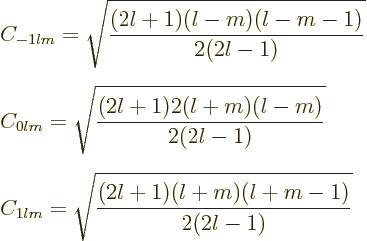|
|
|
|
|
Next: N.14 The electric multipole problem |
|
Angular momenta from different sources can be combined using the Clebsch-Gordan coefficients of chapter 12.7. For example, you can combine orbital and spin angular momenta of a particle that way, or the angular momenta of different particles.
But sometimes you need to multiply angular momentum states of the
same source together. For example, you may need to figure out a
product of spherical harmonics, chapter 4.2.3, like
One way to understand the angular momentum properties of the above product qualitatively is to consider the case that the second spherical harmonic takes the coordinates of an imagined second particle. Then you can use the normal procedures to figure out the properties of the two-particle system. And you can get the corresponding properties of the original one-particle system by restricting the two-particle wave function coordinates to the subset in which the particle coordinates are equal.
Note in doing so that angular momentum properties are directly related to the effect of coordinate system rotations, {A.19}. Coordinate system rotations maintain equality of particle coordinates; they stay within the subset. But inner products for the two-particle system will obviously be different from those for the reduced one-particle system.
And Clebsch-Gordan coefficients are in fact inner products. They are
the inner product between the corresponding horizontal and vertical
states in figures 12.5 and 12.6. The correct
coefficients for the product above are still related to the
Clebsch-Gordan ones, though you may find them in terms of the
equivalent Wigner 3j
coefficients.
Wigner noticed a number of problems with the Clebsch-Gordan coefficients:
 |
(N.1) |
Wigner 3j symbol.Thus Wigner succeeded by his hard work in making physics a bit more impenetrable still than before. A big step for physics, a small step back for mankind.
The most important thing to note about this symbol/coefficient is that
it is zero unless
If all three ![]()
![]()
![]()
If you need an occasional value for such a symbol that you cannot find in figure 12.5 and 12.6 or more extensive tables elsewhere, there are convenient calculators on the web, [[16]]. There is also software available to evaluate them. Note further that {D.65} gives an explicit expression.
In literature, you may also encounter the so-called Wigner
6j” and “9j
symbols. They are typically
written as

The 9j symbol changes by at most a sign under swapping of rows, or of columns, or transposing. It can be expressed in terms of a sum of 6j symbols. There are also 12j symbols, if you cannot get enough of them.
These symbols are needed to do advanced computations but these are far outside the scope of this book. And they are very abstract, definitely not something that the typical engineer would want to get involved in in the first place. All that can be done here is to mention a few key concepts. These might be enough keep you reading when you encounter them in literature. Or at least give a hint where to look for further information if necessary.
The basic idea is that it is often necessary to know how things change under rotation of the axis system. Many derivations in classical physics are much simpler if you choose your axes cleverly. However, in quantum mechanics you face problems such as the fact that angular momentum vectors are not normal vectors, but are quantized. Then the appropriate way of handling rotations is through the so-called Wigner-Eckart theorem. The above symbols then pop up in various places.
For example, they allows you to do such things as figuring out the
derivatives of the harmonic polynomials ![]()
![]()
![]()
All that will be done here is give the derivatives of the harmonic
polynomials ![]() ,
,![]()
![]()
![]()
![]() 1
1



If just having a rough idea of what the various symbols are is not
enough, you will have to read up on them in a book like
[13]. There are a number of such books, but this
particular book has the redeeming feature that it lists some practical
results in a usable form. Some highlights: general expression for the
Clebsch-Gordan coefficients on p. 45; wrong definition of the
3j coefficient on p. 46, (one of the rare mistakes; correct is above),
symmetry properties of the 3j symbol on p. 47; 3j symbols with all ![]()
![]()
other quantum numbers,
as well as the Euler angle.
That is used well before it is defined on p. 33. If you are not
psychic, it can be distracting.